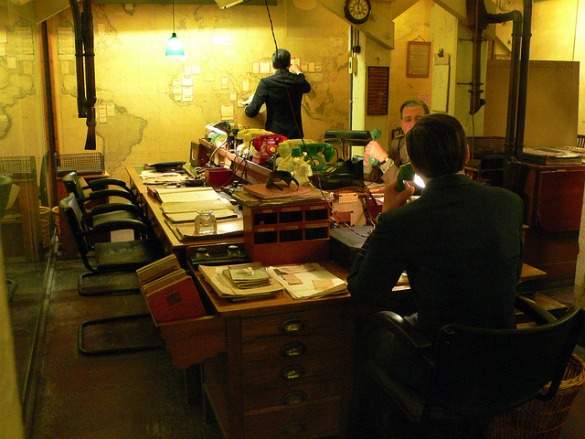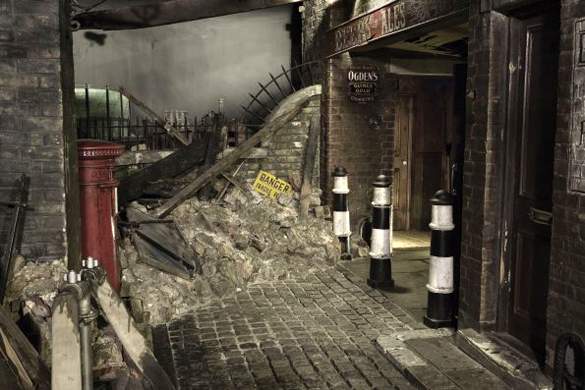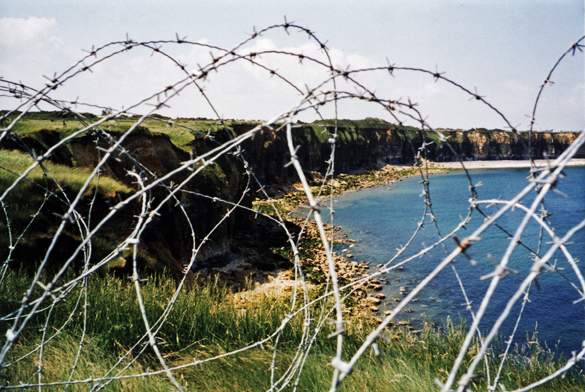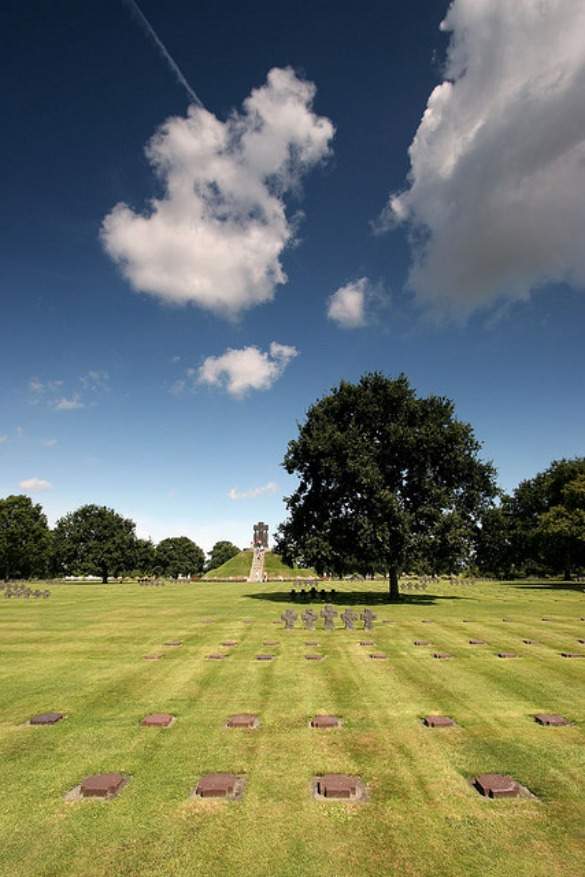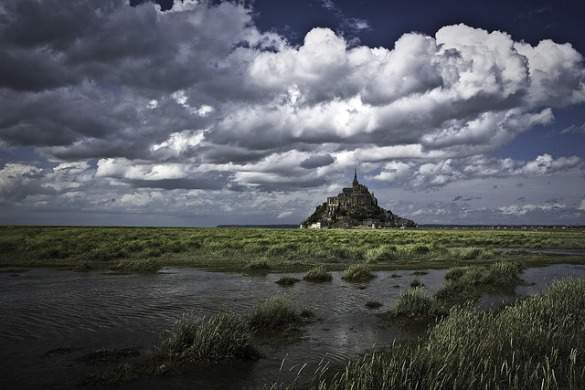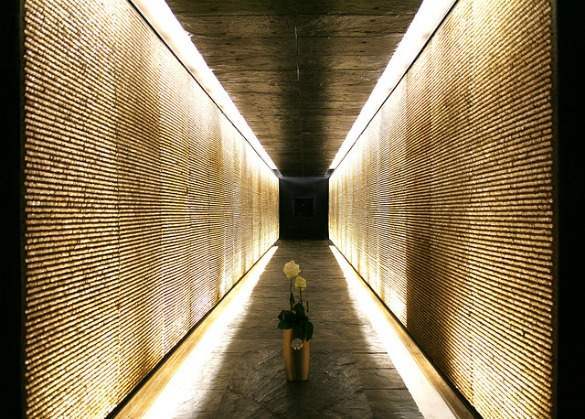In 1940, Europe was ablaze. Britain was battling for survival against the German Air Force, much of France was occupied, and millions of prisoners faced the horrors of concentration camps. Seventy years later, visitors to a peaceful Europe continue to flock to some of the war’s key sites and memorials. Here are several important World War II locations, museums, and monuments to that no history buff should miss on a trip to central Europe.
The Churchill War Rooms – London, England
Summer 1940. The skies above London filled with wave after wave of German bombers and Britain’s tiny Royal Air Force struggled to fend off an enemy preparing to invade the homeland. Observing the heroic struggle, Winston Churchill observed, “Never in the field of human conflict was so much owed by so many to so few.” Churchill’s wartime headquarters was a fortified warren of rooms under a government office building in central London. After the war, the rooms were virtually sealed until the 1980s, when work began to convert them into a museum. Today, visitors can tour the site that is restored to its wartime appearance. The Churchill War Rooms also include the Churchill Museum—which interactively presents the life story of Britain’s iconic leader.
Imperial War Museums – London, England
Winston Churchill’s war bunker was spartan, but it pales in comparison to the conditions experienced by everyday Londoners during the bombing of their city. To get a feel for the realities of daily life during the Blitz, tourists can visit London’s Imperial War Museum. The museum’s Blitz Experience recreates the sights, sounds, smells and feel of a city under siege. The Imperial War Museum covers conflicts from 1914 to present-day, but much of the museum’s collection focuses on World War II. The museum honestly portrays the human side of warfare, including the impact on children and the persecution of “undesirables” by the Nazi regime. There are extensive displays of military hardware from the war—fighter planes and a V-2 German missile loom overhead in the large exhibits gallery.
American Air Museum – Duxford, England
The men and aircraft of the Battle of Britain are memorialized in two other important locations outside of London. Duxford, about 50 miles north of London, is home to another branch of the Imperial War Museum. Located at a former RAF fighter base, this museum contains an extensive collection of aircraft—some of it still in flying form. Duxford hosts a sizable Battle of Britain exhibit housed in a hanger that was used during that conflict.
Duxford is also home to the American Air Museum in Britain. Nearly 30,000 American fliers based in Britain were killed during World War II and this museum is dedicated to their memory. Duxford is just nine miles south of Cambridge, the ancient university town filled with history and more than its share of “Harry Potter at Hogwarts”-style architecture. Cambridge has good rail connections to London, and there are bus connections to Duxford from central Cambridge.
Battle of Britain Memorial – Kent, England
In rural Kent, seventy miles southeast of London, within eyesight of the White Cliffs of Dover, lies the low-key Battle of Britain Memorial. Viewed from the air, the central feature of the monument is clearly a huge in-ground sculpture of a three-bladed aircraft propeller. At ground level, the propeller is less prominent than the stature entitled The Seated Airman—a young World War II flier who appears to look out toward the English Channel. The Battle of Britain Memorial is a homegrown monument created by private donations to the Battle of Britain Memorial Trust, which operates the site. Among the donations are two full-scale replicas of aircraft that fought in the battle: a Hawker Hurricane and its more-famous cousin a Supermarine Spitfire.
The site also includes a memorial wall inscribed with the names of the British airmen who served in the Battle of Britain. The Battle of Britain Memorial is just five miles west of the town of Folkestone, where visitors can enter the Channel Tunnel connecting England to France. The memorial is a similar distance east of the port of Dover, embarkation point for Channel ferries that sail to the Normandy coast.
Pointe Du Hoc – Normandy, France
In about 30 minutes, a Spitfire fighter could fly 150 miles southwest from the Battle of Britain Memorial to the D-Day beaches of Normandy. The names are a part of history: Utah, Omaha, Gold, Juno, and Sword. But at no place was the struggle ashore tougher for the Allied landing force than at Pointe du Hoc. Here American Rangers were forced to scale 100-foot-tall cliffs and capture German coastal guns. German defenders had previously removed the guns, but the dangerous Ranger assault went forward as planned.
Bomb craters are still prominent at Pointe du Hoc and a number of fortifications remain mostly intact. Erosion has endangered the site and repairs are being made to stabilize the cliff face, add walking pathways, and improve the on-site visitor center. The work is scheduled for completion by June 2011. The site is maintained and operated by the American Battlefields Monuments Commission.
American Cemetery – Coleville-Sur-Mer, Normandy
The moving scenes at the start and end of Saving Private Ryan were filmed at the American Cemetery at Coleville-sur-Mer, about eight miles west of Pointe du Hoc. More than 9,000 American servicemen are buried here, marked by rows of bright white crosses and an occasional Star of David.
German Cemetery – La Cambe, Normandy
The visual contrast could not be starker between the American Cemetery at Coleville and the rough-hewn dark crosses at the German military cemetery in La Cambe, six miles south. About 21,000 German war dead are commemorated at La Cambe—most marked with flat grave markers, but some buried in a mass grave mound at the center of the cemetery. There is an information center at the La Cambe cemetery where the names of the dead are recorded on a computerized database. The somber atmosphere of the American cemetery at Coleville is somewhat tempered by tributes to the just cause of the fallen heroes. At La Cambe, there is no just cause, only the stark reality of the cost of war.
Sainte-Mere-Eglise – Normandy, France
The peaceful countryside of Normandy bore the brunt of the Allied assault and many of the quaint villages were badly damaged or destroyed. But if there is any question that the residents of Normandy honor the memory of their liberators, a visit to Sainte-Mère-Église quickly provides the answer. The tiny town was one of the first to be freed from German control by early morning paratroop drops of the US 82nd and 101st Airborne divisions.
One legendary incident was portrayed in the D-Day epic film The Longest Day. An American soldier’s parachute snagged on the steeple of the town church and the unlucky trooper was stuck for hours, feigning death, as the battle raged below. A dummy parachutist is still displayed, swaying from the church steeple and the coat of arms for the town shows two parachutes, with American stars, in the air above the church. The village of Sainte-Mère-Église—about 15 miles west of La Cambe—focuses on D-Day tourism with a small museum, displays at the church, and a scattering of shops and restaurants.
Mont-Saint-Michel, France
And the most-visited place in France—the rocky tidal island of Mont-Saint-Michel—is 50 miles south of Sainte-Mère-Église. Home to an ancient fortified monastery, Mont-Saint-Michel and the surrounding bay is a UNESCO World Heritage site.
Bayeux, France
Although the impact of World War II is evident throughout coastal Normandy, there is more to the region than war-related sights. It is only 35 miles from Sainte-Mère-Église to Bayeux—a pretty Norman city that is home to the historic Bayeux tapestry. The tapestry tells the story of a much earlier conflict when the Normans conquered England in 1066.
Memorial of the Martyrs of the Deportation – Paris, France
It took Allied forces almost three months from landing on Normandy’s beaches until liberating the French capital. Miraculously, Paris escaped virtually unscathed during the war—although its inhabitants suffered mightily under German occupation. Just steps from the soaring spires of Notre Dame cathedral is a memorial to those who suffered the most.
The Memorial of the Martyrs of the Deportation commemorates 200,000 French citizens who were deported to Nazi concentration camps during World War II. Near the exit of the stark, subterranean monument is a simple inscription: Forgive but never forget. It is just 250 miles from Duxford in Cambridgeshire, England to Mont-Saint-Michel in Normandy, France. Seventy years after the war, tourists still travel to these areas to visit some of the most important and accessible World War II sites in Western Europe…and so much more.
Find more things to do in Paris, things to do in Normandy, and things to do in London. Or search for airfare to London or airfare to France.
Photos by: heatheronhertravels, courtesy of Imperial War Museum, courtesy of Imperial War Museum, Duxford, Smudge 9000, David S. White, Mattias Wennström, nitot, Samantha Decker, batigolix, PIXEL TREE, zakgollop
